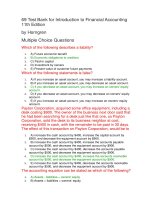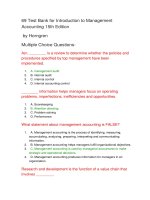Introduction to managerial accounting
Bạn đang xem bản rút gọn của tài liệu. Xem và tải ngay bản đầy đủ của tài liệu tại đây (3.07 MB, 34 trang )
Larry M. Walther
Introduction to Managerial Accounting
Managerial and Cost Accounting
2
Download free eBooks at bookboon.com
Introduction to Managerial Accounting: Managerial and Cost Accounting
1st edition
© 2010 Larry M. Walther, under nonexclusive license to Christopher J. Skousen and
bookboon.com. All material in this publication is copyrighted, and the exclusive property
of Larry M. Walther or his licensors (all rights reserved).
ISBN 978-87-7681-585-1
3
Download free eBooks at bookboon.com
Introduction to Managerial Accounting:
Managerial and Cost Accounting
Contents
Contents
Introduction to Managerial Accounting
6
1
Managerial Accounting
7
1.1
Professional Certiications in Management Accounting
8
2
Planning, Directing, and Controlling
9
2.1
Decision Making
9
2.2
Planning
10
2.3
Strategy
10
2.4
Positioning
13
2.5
Budgets
14
2.6
Directing
15
2.7
Controlling
21
www.sylvania.com
We do not reinvent
the wheel we reinvent
light.
Fascinating lighting offers an ininite spectrum of
possibilities: Innovative technologies and new
markets provide both opportunities and challenges.
An environment in which your expertise is in high
demand. Enjoy the supportive working atmosphere
within our global group and beneit from international
career paths. Implement sustainable ideas in close
cooperation with other specialists and contribute to
inluencing our future. Come and join us in reinventing
light every day.
Light is OSRAM
4
Download free eBooks at bookboon.com
Click on the ad to read more
Introduction to Managerial Accounting:
Managerial and Cost Accounting
Contents
3
Cost Components
25
4
Product Versus Period Costs
27
4.1
Period Costs
27
5
Financial Statement Issues that are Unique to Manufacturers
28
5.1
Schedule of Raw Materials
28
5.2
Schedule of Work in Process
30
5.3
Schedule of Cost of Goods Manufactured
30
5.4
Schedule of Cost of Goods Sold
31
5.5
he Income Statement
31
5.6
Reviewing Cost of Flow Concepts for a Manufacturer
31
5.7
Critical hinking About Cost Flow
33
360°
thinking
.
Discover the truth at www.deloitte.ca/careers
5
Download free eBooks at bookboon.com
© Deloitte & Touche LLP and affiliated entities.
Click on the ad to read more
Introduction to Managerial Accounting:
Managerial and Cost Accounting
Introduction to Managerial Accounting
Introduction to Managerial
Accounting
Your goals for this “managerial accounting introduction” chapter are to learn about:
• he distinguishing characteristics of managerial accounting.
• he role of managerial accounting in support of planning, directing, and controlling.
• Key production cost components: direct materials, direct labor, and factory overhead.
• Product costs versus period costs.
• Categories of inventory for manufacturers and related inancial statement implications.
6
Download free eBooks at bookboon.com
Introduction to Managerial Accounting:
Managerial and Cost Accounting
Managerial Accounting
1 Managerial Accounting
Early portions of this textbook dealt mostly with inancial accounting. Financial accounting is concerned
with reporting to external parties such as owners, analysts, and creditors. hese external users rarely have
access to the information that is internal to the organization, nor do they specify the exact information
that will be presented. Instead, they must rely on the general reports presented by the company. herefore,
the reporting structure is well deined and standardized. he methods of preparation and the reports
presented are governed by rules of various standard-setting organizations. Furthermore, the external
users generally see only the summarized or aggregated data for an entity.
In contrast, managers of a speciic business otentimes need or desire far more detailed information.
his information must be tailored to speciic decision-making tasks of managers, and its structure
becomes more “free formed.” Such managerial accounting information tends to be focused on products,
departments, and activities. In this context, the management process is intended to be a broad reference
to encompass marketing, inance, and other disciplines. Simply stated: managerial accounting is about
providing information in support of the internal management processes. Many organizations refer to
their internal accounting units as departments of strategic inance. his title is more relective of their
wide range and scope of duties.
Managerial accounting is quite diferent from inancial accounting. External reporting rules are replaced
by internal speciications as to how data are to be accumulated and presented. Hopefully, these internal
speciications are suiciently logical that they enable good economic decision making. For example,
speciic reporting periods may be replaced with access to real-time data that enable quick responses to
changing conditions. And, forecasted outcomes become more critical for planning purposes. Likewise,
cost information should be disseminated in a way that managers can focus on (and be held accountable
for!) those business components (“segments”) under their locus of control.
In short, the remainder of this book is about the ideas and methods that can be used to provide accounting
information in direct support of the “broadly deined” role of managing a business organization. If you
aspire to work in strategic inance, the remainder of this book is your introductory primer. But, for
most readers – those who must manage some part of an organization – the remainder of this book is
your guide to knowing how and when the management accountant’s tools can be used to help you do
your job better!
7
Download free eBooks at bookboon.com









